- Python development: key benefits
- The Django vs FastAPI frameworks in web development
- The Django and FastAPI frameworks in web development
- Our expertise in Django and FastAPI development
- Perspectives on Python’s Role in Software Development
- Conclusion
Software development landscape is continually evolving, with an ever-expanding toolkit. Now, numerous programming languages have become standard tools in the developer’s arsenal. Each of them is supported by a portfolio of projects and frameworks.
However, some languages lead the pack, and Python is one of the prime examples. In fact, data shows that Python is the choice for a significant portion of new projects, and we’ll explore some of the compelling reasons why this is the case in this article.
I’ll explore two Python frameworks: one a longstanding favorite, Django, the other a more recently introduced rising star, FastAPI for large projects. Through my insights and advice, you’ll gain a broader understanding of Django Python development services, and the myriad options available within this web development technology stack.
Python development: key benefits
As a custom web development agency, we specialize in using Python for backend development, and JavaScript for the frontend. With numerous frameworks available for each language, Python/Django web development services naturally stand out for backend architecture.
But whilst Django undoubtedly remains the front-runner, there’s also a new contender in town — FastAPI. This emerging framework is quickly making a name for itself, challenging Django‘s long-standing dominance.
While we’ve built a reputation for our Django development services, we readily embrace the new possibilities that come with FastAPI. As aficionados of Python, we’re invigorated by how the language continually reveals its rich potential through new frameworks.
If you’re still looking for proof of our passion for Python, consider these two case studies from our portfolio:
- For our travel startup, which attracts hundreds of thousands of visitors each month, we chose Python/Django.
- We used Python/FastAPI, and a microservice architecture, to develop a pricing marketplace that sees over 10 million monthly visitors for one of our biggest clients.
Convinced? If you’re still on the fence, let’s take a closer look into the capabilities of these technologies and explore why they’re chosen by everyone from YouTube to the latest startups.
When discussing Python and Django development services, it’s worth noting some of the famous websites built using Python. After conducting an in-depth study, we even authored a dedicated article on the subject. Highlights include renowned platforms like Instagram, Mozilla, Pinterest, Disqus, Spotify, Bitbucket, National Geographic, Udemy, Coursera, Indeed, Opera, YouTube, NASA, Dropbox, and Clubhouse.
Such a remarkable lineup speaks for itself, and these high-profile projects stand as a testament to the technology’s reliability and effectiveness. In our environment, the steady demand we’re seeing for custom Django development services also speaks volumes.
Python has several core advantages over other technologies:
- Rapid Development: Python’s concise and expressive syntax significantly speeds up development, particularly useful for prototyping and testing new ideas swiftly.
- Code Execution Speed Concerns: While some developers point out Python’s slower execution speed compared to compiled languages, the efficiency of modern computing largely offsets this. Plus, Python’s rapid coding capabilities, along with techniques for optimizing processor-intensive sections, make it highly effective for custom development.
- Memory Management: Python’s interpreter automatically manages memory, freeing up resources no longer in use. This reduces code complexity and minimizes the risk of memory-related errors.
- Rich Libraries and Packages: Python’s extensive collection of ready-made solutions significantly streamlines programming. It boasts a comprehensive standard library packed with modules and functions designed for rapid code development. Beyond this, developers have access to a wide range of standard packages, alongside the option to choose suitable open-source packages from public repositories, enhancing flexibility and efficiency in coding projects.
- Versatility: We’ve witnessed first-hand how Python finds applications in virtually every area of software development, from image processing and data analysis to artificial intelligence, including machine learning, and web development.
- Vibrant Community: The large and active Python community fosters the development of new tools and provides comprehensive documentation and support, including detailed solutions on forums like StackOverflow.
- Ease of Learning: With its straightforward syntax and clear instructions, Python is accessible to beginners, continuously refreshing the pool of Python developers and easing recruitment challenges.
- High-Level Language: Python abstracts away many details of computer architecture, allowing developers to focus on coding logic rather than system specifics.
- Portability: Python programs can run on various systems without needing to recompile it. Thanks to interpreters, programs written in Python can run on any platform.
- Extensibility: The ability to integrate custom libraries and modules enhances Python’s flexibility for diverse development needs.
- Security and Reliability: Python’s design emphasizes security and stability. This makes it a trusted choice.
These points not only stress the most important Python’s capabilities. They let you understand why it’s so valued in the development community.
Need Python developers?
Develop your solution leveraging the expertise and vast experience of our Python development team.
The Django vs FastAPI frameworks in web development
Let’s introduce the Django and FastAPI frameworks by comparing and contrasting their main features, starting by defining the primary purpose of each framework to ensure a fair comparison.
Django is a full-stack web framework that offers developers a complete suite of tools for web development projects. Its versatility makes it capable of supporting the backend for complex websites, and makes Django a universally applicable framework.
On the other hand, FastAPI is a lightweight framework geared towards building high-performance APIs. Designed with a focus on speed and security, FastAPI is ideal for API-centric projects but is also beginning to excel in broader applications, including microservices. (Psst. Remember our pricing marketplace project that attracted 10 million monthly visits? We witnessed FastAPI’s versatility first-hand during its development).
Of course, web development never stops, and languages and frameworks evolve. After some time, FastAPI may eventually expand into becoming a universal full-stack framework, but its developers haven’t yet gone in this direction.
So, let’s look in more detail at how the two frameworks currently compare.
Django is often referred to as a comprehensive «all-in-one» solution, offering an entire ecosystem of packages and tools that equip users to build web applications. This includes a robust ORM (Object Relational Mapping) system and sophisticated modeling capabilities. Over its lifespan, Django has amassed a comprehensive collection of libraries, packages, and tools, expanding its capabilities.
In contrast, FastAPI has relied on pre-existing resources such as the Pydantic libraries for data handling, and the Starlette framework/toolkit for web functionalities. As a micro web framework, FastAPI is significantly lighter and smaller than Django, inevitably leading to enhanced performance, and as a natural extension of this, FastAPI is also much faster than Django. In fact, FastAPI is considered one of the fastest of all Python web frameworks.
In terms of security, Django has advantages with its comprehensive built-in features designed to mitigate common cyber threats. Django also excels in scalability, enabling swift adjustments to the web system in response to changing demands.
The approach to documentation differs significantly between the two; Django’s comprehensive documentation is well-renowned for its quality, but it is not interactive. This contrasts with FastAPI’s browser-based documentation and automatically rendered according to the OpenAPI specification.
Many Python experts, including ourselves, have already accumulated a set of solutions that work to overcome Django’s weaknesses. For example, as Django does not support REST (Representational state transfer) API, in situations where this is critical, the issue is solved by using the Django REST framework. Many similar examples can be cited.
Much has been written about the mass use of Django web development services, including in our blog, and the increasing use of FastAPI is gradually adding to the numbers of successful cases. Netflix, for instance, chose FastAPI for its crisis management orchestration framework, Dispatch, focusing on seamless integration with existing tools like Slack, GSuite, and Jira.
In summary, Django serves as a comprehensive web framework, offering a complete toolkit for creating feature-rich websites efficiently, even complex ones. On the other hand, FastAPI’s simplicity and focus on APIs make it particularly useful for projects with an API-first approach.
For now, they are frameworks with different purposes, but which both greatly enhance possibilities when using Python in web development. Choosing the right framework depends on the project’s specific needs and goals. We recommend consulting with experts to guide this decision. This helps ensure the selected framework aligns with your project’s requirements. Should you need assistance, we’re here to help determine the best fit for your project and clarify the benefits it offers.
The Django and FastAPI frameworks in web development
These frameworks have many similarities and sometimes can even be used interchangeably. However, there are still some things that set them apart. With Django’s focus on structured development and FastAPI being more flexible, they may be a good fit for different projects.
Common Django use cases in web development
- CMS development. Offering a built-in admin interface, this framework is ideal for creating Content Management Systems (CMS).
- eCommerce projects. Django robust features like user authentication, payment integration, and product management make it a great fit for eCommerce systems.
- Web applications. This framework is flexible and has a modular architecture, which allows using it in web app development.
Common FastAPI use cases in web development
- Machine learning. FastAPI’s asynchronous nature and integration with machine learning libraries like TensorFlow and PyTorch make it a popular choice for dealing with vast amounts of simultaneous requests.
- SPA. You can use this high-performance and fast framework to create the backend API for projects on React, Vue.js and Angular to deliver data to the frontend.
- Cloud services. Due to its performance and scalability, FastAPI is often used for building cloud-native applications and microservices.
FastAPI is also often used when developing high-load applications with millions and tens of millions of users.
Build your Django/FastAPI project with us
Get a qualified and experienced team of software engineers to enhance the development of your future solution.
Our expertise in Django and FastAPI development
We have vast experience in building Django and FastAPI solutions for different domains. Here we offer a few cases from our experience. We built our own travel startup using Django framework – CountryHelper. Initially, it was built based on monolithic architecture. It has quite resource-intensive functionality with mapping solutions. That’s why dealing with loads efficiently is imperative for this project. Once the website hit the number of 100,000 users per month, we decided to transition it to microservices. We started using FastAPI at the same time with Django and transitioned some functionality to FastAPI. This allowed us to increase speed and we gradually moved the entire application to microservices. It is a common case when monolithic applications based on Django are transitioned to microservices and FastAPI framework.
We also developed a large e-commerce marketplace with over 10 million users per month on Django. As the load was increasing, we realized that we need to switch to microservices and increase speed. In our experience, we often combine Django with FastAPI in the same solution, using FastAPI as a basis and adding Django for less demanding tasks.
Our project for PepsiCo is another example. We have built a website for their marketing campaigns. At first, we mainly used Djangothere. Now, new solutions are built on FastAPI, as this framework offers high loads and it is faster to complete such projects.
Perspectives on Python’s Role in Software Development
Keeping track of popular tech trends is crucial not just for identifying the leading tools currently in use, but also for understanding the broader effects of a technology’s popularity. When it comes to programming languages, popularity ensures a larger pool of individuals eager to work with it, leading to a steady supply of skilled professionals. This, in turn, often results in lower costs for both using and maintaining the technology.
Python is very popular. According to data from GitHub, the world’s largest code host, with (as of early 2020) 40 million users and 190 million repositories, Python is currently the most used language out of the top 50, which underscores just how widely adopted it is.
Python’s vast community, comprehensive tools, and extensive documentation make it an appealing option for businesses looking to build development teams affordably. The rich resources available to Python developers mean they often have pre-existing solutions for the language’s common problems, leading to lower ongoing maintenance costs.
Maintenance expenses for any web service can vary widely with the project’s size and complexity, but it’s important to note that a considerable part of these costs goes to team compensation. Data consistently shows that Python developers tend to have lower salary demands compared to specialists in other technologies, further establishing Python as a more economical choice.
Ultimately, putting together a team of talented Python experts at affordable rates is very doable. This is great news for businesses of all sizes, including startups, who are looking at maximizing their technology investments.
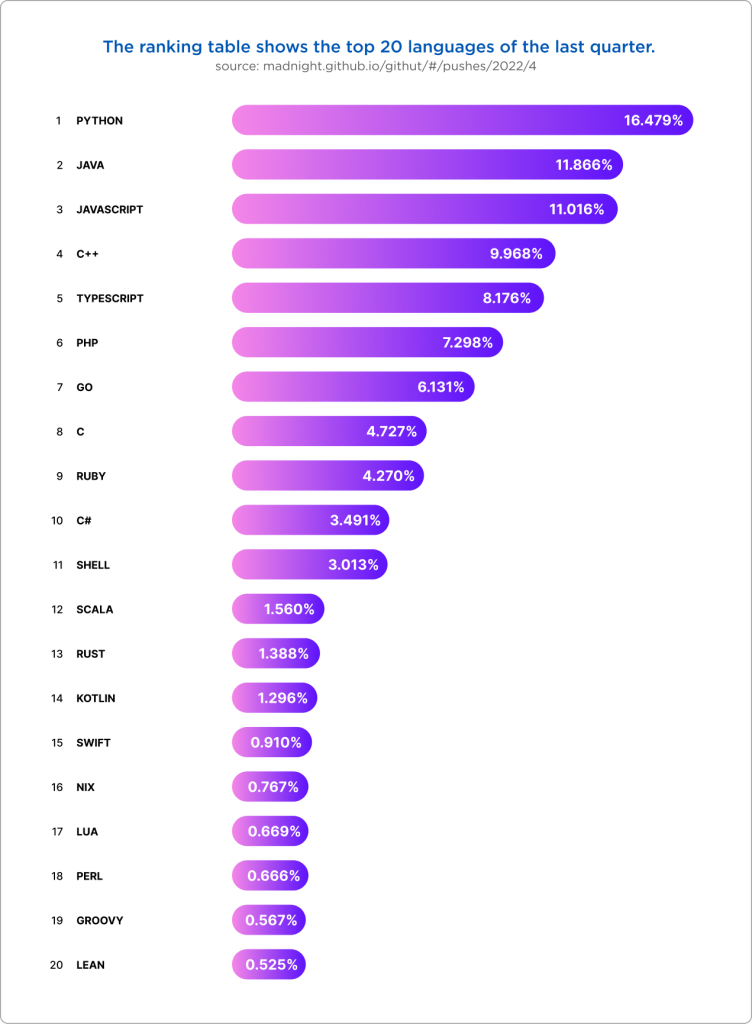
The chart below, based on GitHub retrospective data, shows the almost constant presence of Python among the ten most popular languages since at least the second quarter of 2012.
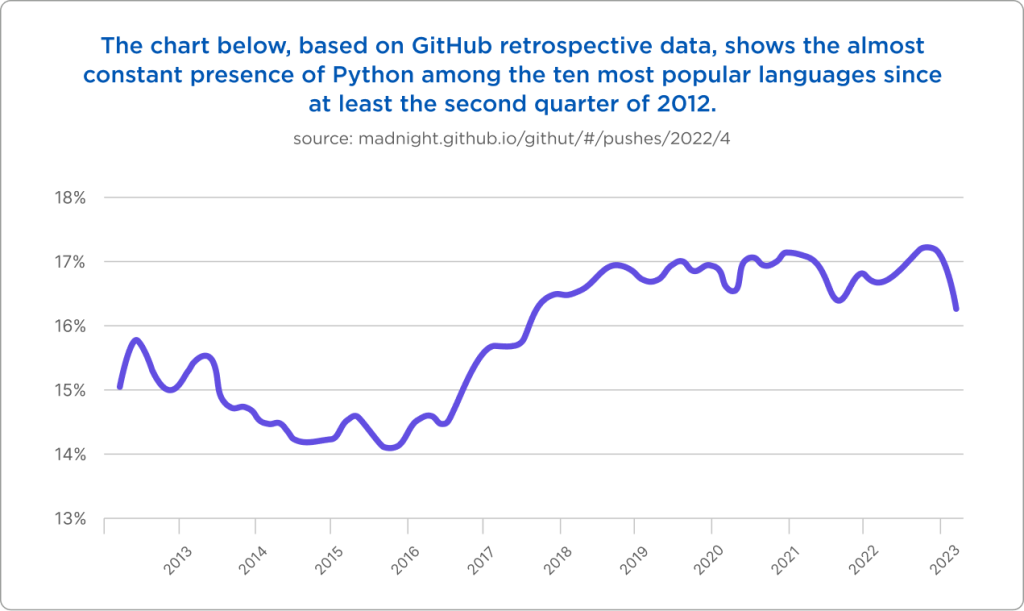
Please note that Python’s leading position as a web development tool is consistent across many reviews and polls, and is quite unanimous. For example, here is a 2022 developer survey by Stackoverflow.
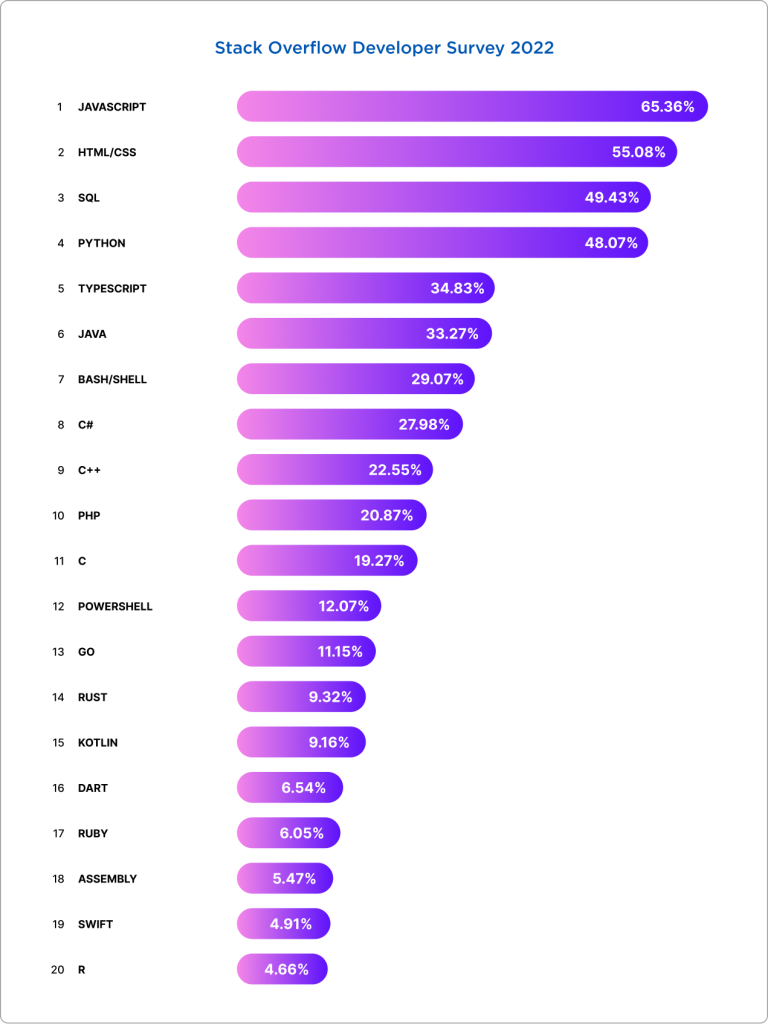
These survey results from the StackOverflow website show the current state of play on one hand, and on the other, the direction of further development of events.
Notably, among those respondents learning to code, interest in Python was even higher, as indicated by the separate summary of survey responses from this group.
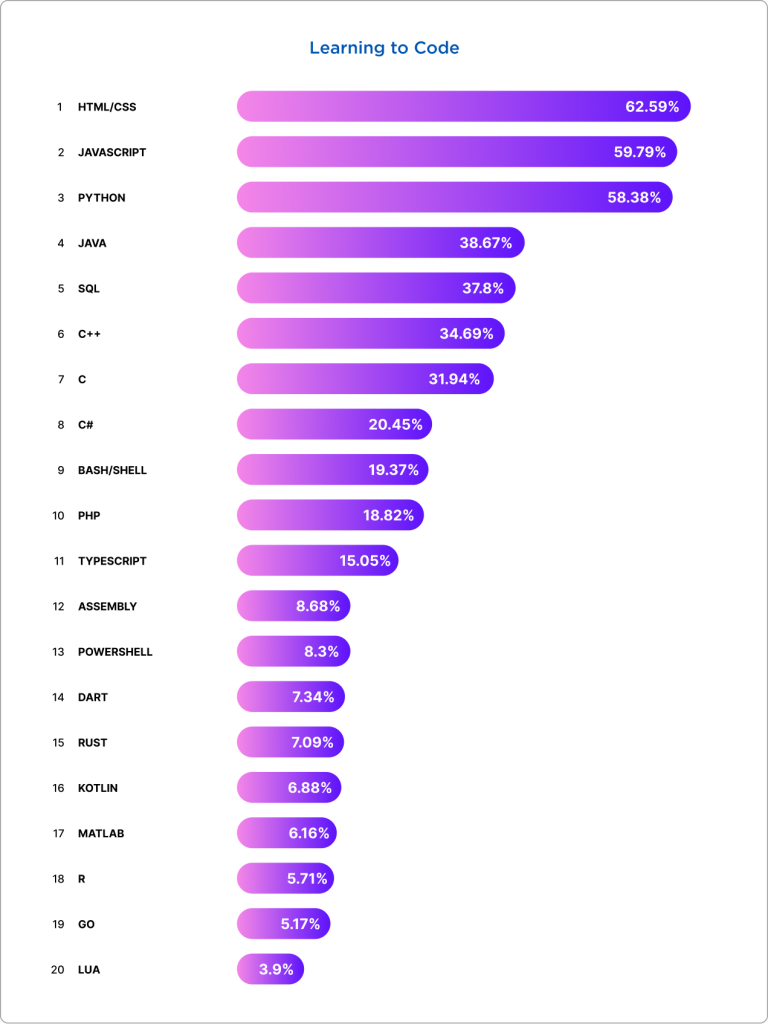
However, experienced developers also recognize the importance of learning Python to boost their skills and increase their value to employers. According to our referenced survey, 17.59% of programmers not currently using a certain language or technology are interested in developing with Python.
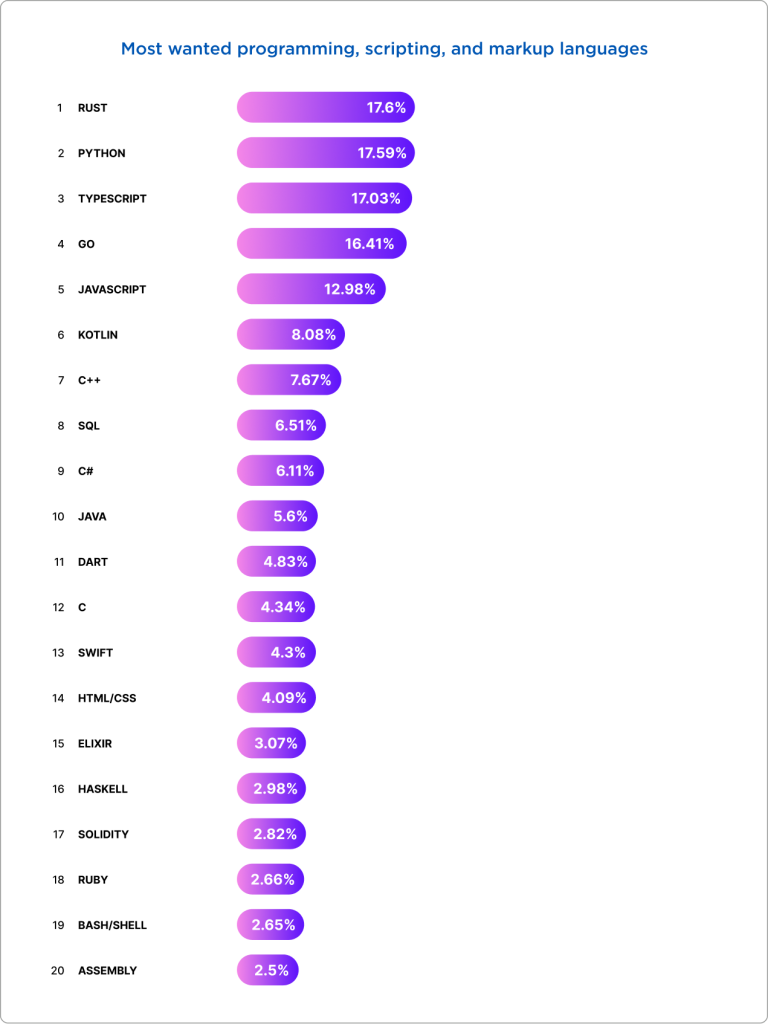
The situation is similar with frameworks: Django consistently ranks in the top ten, while FastAPI is quickly gaining popularity and is poised to join the ranks.
Professional opinion deems both frameworks promising for learning. Specifically, 7.89% of developers are interested in Django, and 4.94% are keen on learning FastAPI. Both frameworks rank in the top ten for attracting interest from developers who haven’t yet worked with them but are considering doing so.
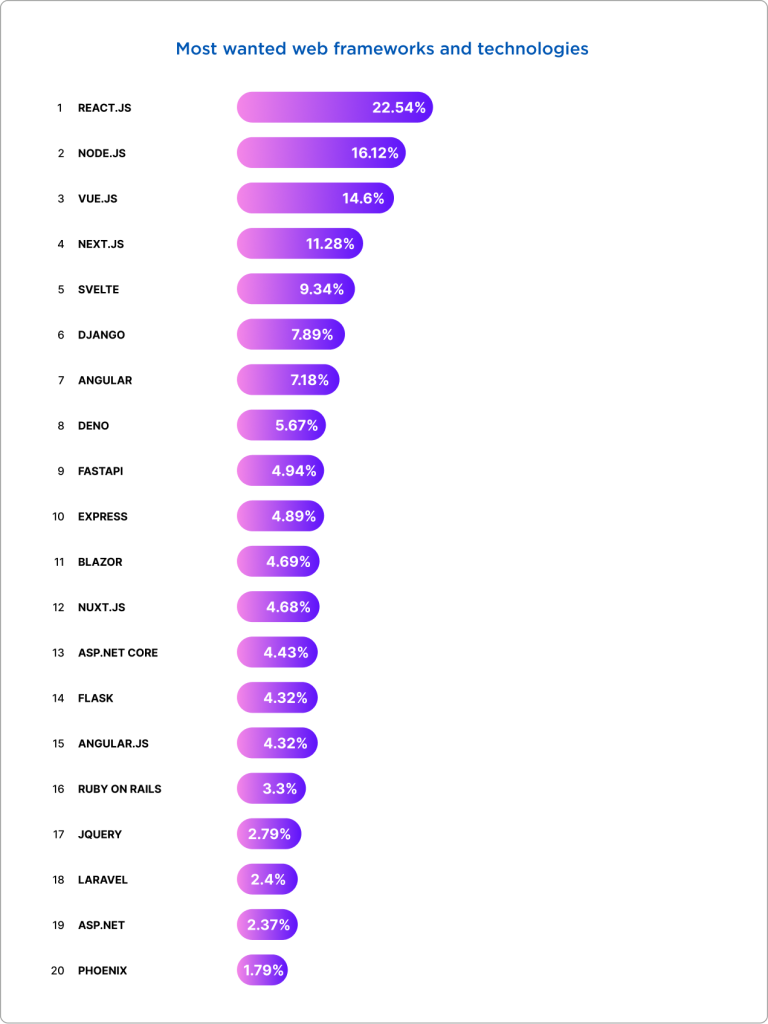
Turning to statistics that highlight one of Python’s key advantages mentioned earlier—an abundance of ready-made solutions and tools. There is clearly keen interest in Python development services and the use of other Python frameworks, with FastAPI notably standing out. This interest in relevant libraries and packages underscores the appeal of Python’s ecosystem.
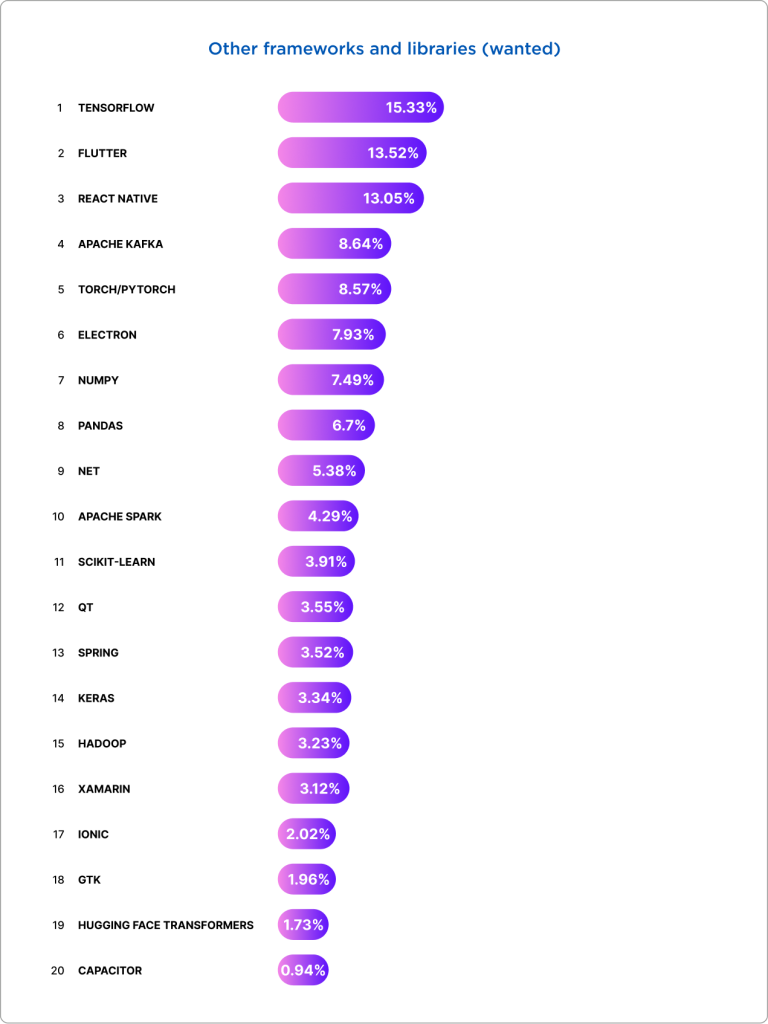
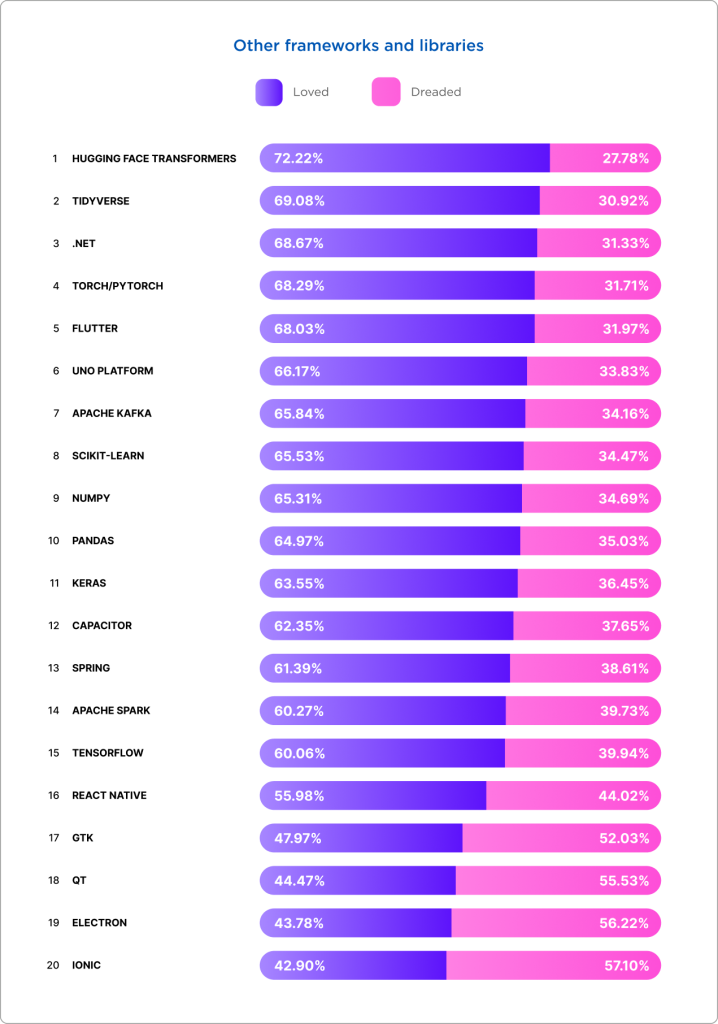
As you can see, there are quite a few titles associated with Python amongst these rankings of libraries that developers love and want to use more widely.
- TensorFlow, which is a free and open-source software library. This library can be useful in several programming languages, including Python.
- NumPy — a software library for Python.
- Pandas — a software library for Python.
- Scikit-learn — a free software library for Python.
- PyTorch — a highly specialized framework based on the Torch library, etc.
As can be seen from the data we’ve shared with you, the popularity of Python and the solutions and tools offered in this language very much represents a long-term trend. Therefore, there are plenty of reasons to expect further growth in the number of web development projects using these technologies.
As I wrote at the beginning of the article, at SECL Group, Python is our main specialization when it comes to building the backend of web products. We have helped create startups using this language, including our own, across various domains.
We also use Python to create internal platforms for large corporations. Our portfolio includes, for example, financial platforms for banks, which we also made using Python/Django. Over the last two years, we have also started to actively apply Python/FastAPI as another modern technical option in addition to Django.
As I outlined earlier, there is no doubt that these two frameworks are slightly different, so I advise in each specific case that projects are analyzed in order to select the most appropriate tech stack. By briefly reviewing your project, we will help you weigh the pros and cons and reasonably choose a framework.
In any case, Python/FastAPI and Python/Django are fairly versatile web development technologies that are used very commonly and have the potential to deliver excellent results.
Conclusion
To wrap up, Python and its frameworks, such as Django and FastAPI, are integral components of the tech stack for modern web projects. These technologies offer numerous benefits, making them highly sought after in the market. Attributes like rapid development speed, extensive functionality, and relatively low maintenance costs are crucial for the success of any project. The capabilities of Python and Django development services continue to grow, fueled by an active and extensive expert community that creates tools and ready-made solutions. FastAPI, a recent addition to the Python ecosystem, has further enhanced the family with its quality contributions.
Having specialized in Python and its frameworks for the last decade, at SECL Group we are fully convinced of their benefits. We have honed our skills in their application and confidently recommend them to our clients. Our deep knowledge and experience enable us to leverage Python, Django, and FastAPI to their fullest potential across various web products. We are eager to assist you in selecting the right technologies for your website. Our tech leads are available for free consultations to address your inquiries. Reach out to us to discuss preparing and launching your web development projects.